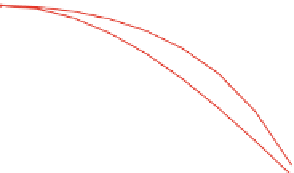Environmental Engineering Reference
In-Depth Information
Fig. 7.4 a E
z
field profile of the TE polarization at h
¼
80
with the wavelength of 435 nm;
b H
z
field profile of the TM polarization at h
¼
80
with the wavelength of 755 nm. 2011 OSA;
Ref. [
16
]
(a)
(b)
0.35
0.35
Strip
Strip (Cosine Law)
Non−Strip
Non−Strip (Cosine Law)
Strip
Strip (Cosine Law)
Non−Strip
Non−Strip (Cosine Law)
Plasmonic Effects
0.3
0.3
0.25
0.25
0.2
0.2
0.15
0.15
0.1
0.1
0.05
0.05
0
0
0
10
20
30
40
50
60
70
80
0
10
20
30
40
50
60
70
80
Angle (Degree)
Angle (Degree)
Fig. 7.5 The total absorptivity as a function of the incident angle h. The generalized Lambert's
cosine law (straight-dotted and dash-dotted curves) is calculated by A
0
cos h, where A
0
is the total
absorptivity under the vertical incidence condition. a TE polarization; b TM polarization. 2011
OSA; Ref. [
16
]
slower than that for the TE polarization, which is independent of the structure.
This feature may be understood by the fact that better light confinement can be
achieved for the TM-polarized light where the E-field is not continuous across
inhomogeneous material interfaces. For the TE polarization, the absorption of the
strip structure becomes comparable to that of the nonstrip structure near grazing
angles. The narrow absorption peaks due to the Wood's anomalies can improve the
total absorption, but the improvement is smaller than that from the SPRs in the
TM-polarized light. For the TM polarization, the plasmon-induced absorption
enhancement strongly breaks the limit of the generalized Lambert's cosine law
and shows the ''super-Lambertian'' absorption. The broadband and wide-angle
























































































Search WWH ::

Custom Search